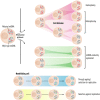Inheritance of mitochondrial DNA in humans: implications for rare and common diseases
- PMID: 32187761
- PMCID: PMC8641369
- DOI: 10.1111/joim.13047
Inheritance of mitochondrial DNA in humans: implications for rare and common diseases
Abstract
The first draft human mitochondrial DNA (mtDNA) sequence was published in 1981, paving the way for two decades of discovery linking mtDNA variation with human disease. Severe pathogenic mutations cause sporadic and inherited rare disorders that often involve the nervous system. However, some mutations cause mild organ-specific phenotypes that have a reduced clinical penetrance, and polymorphic variation of mtDNA is associated with an altered risk of developing several late-onset common human diseases including Parkinson's disease. mtDNA mutations also accumulate during human life and are enriched in affected organs in a number of age-related diseases. Thus, mtDNA contributes to a wide range of human pathologies. For many decades, it has generally been accepted that mtDNA is inherited exclusively down the maternal line in humans. Although recent evidence has challenged this dogma, whole-genome sequencing has identified nuclear-encoded mitochondrial sequences (NUMTs) that can give the false impression of paternally inherited mtDNA. This provides a more likely explanation for recent reports of 'bi-parental inheritance', where the paternal alleles are actually transmitted through the nuclear genome. The presence of both mutated and wild-type variant alleles within the same individual (heteroplasmy) and rapid shifts in allele frequency can lead to offspring with variable severity of disease. In addition, there is emerging evidence that selection can act for and against specific mtDNA variants within the developing germ line, and possibly within developing tissues. Thus, understanding how mtDNA is inherited has far-reaching implications across medicine. There is emerging evidence that this highly dynamic system is amenable to therapeutic manipulation, raising the possibility that we can harness new understanding to prevent and treat rare and common human diseases where mtDNA mutations play a key role.
Keywords: human mitochondrial DNA; mitochondrial DNA mutation; mitochondrial bottleneck; mitochondrial disorders; mitochondrial inheritance.
© 2020 The Authors. Journal of Internal Medicine published by John Wiley & Sons Ltd on behalf of Association for Publication of The Journal of Internal Medicine.
Conflict of interest statement
No conflicts of interest were declared.
Figures



Similar articles
-
Biparental Inheritance of Mitochondrial DNA in Humans.Proc Natl Acad Sci U S A. 2018 Dec 18;115(51):13039-13044. doi: 10.1073/pnas.1810946115. Epub 2018 Nov 26. Proc Natl Acad Sci U S A. 2018. PMID: 30478036 Free PMC article.
-
Nuclear-mitochondrial DNA segments resemble paternally inherited mitochondrial DNA in humans.Nat Commun. 2020 Apr 8;11(1):1740. doi: 10.1038/s41467-020-15336-3. Nat Commun. 2020. PMID: 32269217 Free PMC article.
-
Mitochondrial disease in childhood: mtDNA encoded.Neurotherapeutics. 2013 Apr;10(2):199-211. doi: 10.1007/s13311-012-0167-0. Neurotherapeutics. 2013. PMID: 23224691 Free PMC article. Review.
-
Mitochondria and Their Role in Human Reproduction.DNA Cell Biol. 2020 Aug;39(8):1370-1378. doi: 10.1089/dna.2019.4807. Epub 2019 Oct 11. DNA Cell Biol. 2020. PMID: 31603716 Review.
-
Genetic Counselling for Maternally Inherited Mitochondrial Disorders.Mol Diagn Ther. 2017 Aug;21(4):419-429. doi: 10.1007/s40291-017-0279-7. Mol Diagn Ther. 2017. PMID: 28536827 Review.
Cited by
-
Mitochondrial genome study in blood of maternally inherited ALS cases.Hum Genomics. 2023 Jul 28;17(1):70. doi: 10.1186/s40246-023-00516-1. Hum Genomics. 2023. PMID: 37507754 Free PMC article.
-
Clinical Approaches for Mitochondrial Diseases.Cells. 2023 Oct 20;12(20):2494. doi: 10.3390/cells12202494. Cells. 2023. PMID: 37887337 Free PMC article. Review.
-
Extensive analysis of mitochondrial DNA quantity and sequence variation in human cumulus cells and assisted reproduction outcomes.Hum Reprod. 2021 Dec 27;37(1):66-79. doi: 10.1093/humrep/deab231. Hum Reprod. 2021. PMID: 34755183 Free PMC article.
-
Mitochondrial Cardiomyopathy: Distinctive Cardiac Phenotype Detected with Cardiovascular MRI.Radiol Cardiothorac Imaging. 2023 Apr 13;5(2):e230014. doi: 10.1148/ryct.230014. eCollection 2023 Apr. Radiol Cardiothorac Imaging. 2023. PMID: 37124643 Free PMC article.
-
Family misfortune caused by hereditary bias: a reflection on mitochondrial disease diagnosis in a family.J Assist Reprod Genet. 2025 Mar;42(3):991-996. doi: 10.1007/s10815-025-03399-4. Epub 2025 Feb 12. J Assist Reprod Genet. 2025. PMID: 39937390 Free PMC article.
References
-
- Wallace DC. Mitochondrial genetic medicine. Nat Genet 2018; 50: 1642–9. - PubMed
-
- Stewart JB, Chinnery PF. The dynamics of mitochondrial DNA heteroplasmy: implications for human health and disease. Nat Rev Genet 2015; 16: 530–42. - PubMed
-
- Vafai SB, Mootha VK. Medicine. A common pathway for a rare disease? Science 2013; 342: 1453–4. - PubMed
-
- Wallace DC, Singh G, Lott MT et al. Mitochondrial DNA mutation associated with Leber's hereditary optic neuropathy. Science 1988; 242: 1427–30. - PubMed
-
- Holt I, Harding AE, Morgan‐Hughes JA. Deletion of muscle mitochondrial DNA in patients with mitochondrial myopathies. Nature 1988; 331: 717–9. - PubMed
Publication types
MeSH terms
Substances
Grants and funding
LinkOut - more resources
Full Text Sources
Medical

